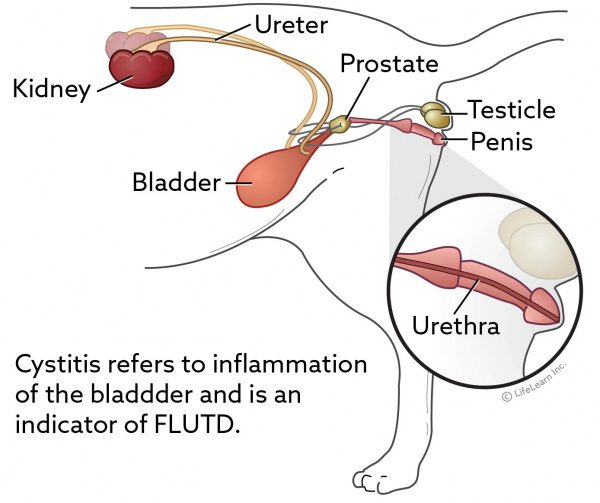
Symptoms and treatment of cystitis in cats, forms of the disease and its prevention
The most common disease in cats is inflammation of the bladder or otherwise cystitis. The disease is quite insidious, it is difficult to treat, and the saddest thing is that it is prone to relapse. If this disease affects a pet, both the pet itself suffers, constantly experiencing pain, and its owners, who are forced to treat their pet’s cystitis for a long time and hard. In addition, a bad smell, constant puddles throughout the apartment and worries about a poor animal can inadvertently cause thoughts of putting it to sleep. Can cystitis be cured?
Contents
Cystitis in cats – treatment
The bladder is a hollow organ that grows and shrinks in size. Inside, it is a submucosa covered with mucous tissue and blood vessels. The mucosa of the bladder is always subject to heavy loads. Its inflammation is a disease called cystitis.
Symptoms of the disease
How to recognize the beginning of cystitis in your pet? At the first stage of the disease, you are unlikely to notice them. However, if you often watch your pet, you will surely notice the following changes:
- she has increased urination;
- thirst (the cat will often drink);
- the cat does not allow touching the stomach.
It is worth considering that these signs are quite common in other diseases, as well as talking about approaching heat. It is for this reason that most owners do not turn to a specialist immediately, but after a while, when the symptoms of cystitis become more noticeable:
- during urination, the cat groans plaintively;
- trips are becoming more frequent not only to the tray, but also past it (typical even for well-mannered cats);
- sometimes cats urinate specifically in a prominent place – clothes or upholstered furniture, without hiding;
- urine acquires a cloudy dark color of heterogeneous consistency, sometimes with blood clots or grayish patches (pus);
- after urination, it is difficult for a cat to step on its hind limbs, and when resting, it tends to gently roll over to its left or right side, experiencing discomfort;
- her abdomen becomes tight and obviously painful;
- it becomes difficult for the cat to urinate, she pushes when urinating.
Causes of cystitis
Cystitis in cats can resolve in acute or chronic form. With a chronic form of inflammation, your pet will feel quite normal, only occasionally experiencing discomfort while walking in the tray. You should not think that this form of the disease is less dangerous, since the exacerbation phase can begin at any time.
In addition, a disease that goes unnoticed by you in a cat can undermine health, turning from a sluggish disease into a real problem, gradually destroying the entire body and shortening the years of your pet’s life.
With more severe damage to the mucosa and rupture of blood vessels, cat urine gets blood clots. According to such signs, experts diagnose hemorrhagic cystitis. This type of inflammation can also be acute or chronic. Hemorrhagic cystitis can cause anemia, blockage of the ducts, intoxication. The cause of such a dangerous disease may be the appearance of stones in the kidneys or bladder of a cat.
The most difficult diagnosis for specialists is idiopathic cystitis. It is characterized by the absence of signs in which the pathological process develops. Symptoms may be overt or covert, and the animal may appear perfectly healthy or barely able to stand on its paws. The main feature of this form of the disease is the absence of visible causes of the appearance of cystitis – the work of all organs is carried out without failures, and the results of ultrasound and tests are normal.
Before you start treatment or try to drown out the pain of your pet with painkillers, you need to understand resulting in inflammation. The following factors can provoke such a serious and dangerous disease:
- improper diet;
- fasting or overeating;
- the appearance of infections;
- chronic illness;
- poor quality of drinking water;
- urolithiasis disease;
- stress;
- injuries and others.
In order for the treatment to be most effective and for your pet to recover faster, it is necessary to understand and eliminate the causes of the disease.
Treatment of cystitis in cats
So, having found symptoms of inflammation in your cat, you must first go for an examination to a veterinary clinic. You should not deal with the treatment of a cat on your own, stuffing it with all kinds of painkillers. Their action will end sooner or later, and the insidious disease will not go anywhere. The exact treatment can be prescribed by a specialist after a thorough examination of the animal.
On examination by a veterinarian perform an ultrasound examination, will take the necessary tests (blood and urine). The doctor will determine the cause of inflammation of the bladder according to the results of the tests and only then prescribe the necessary treatment. Until that time, you will have to give the animal painkillers and antispasmodic drugs that a specialist will prescribe.
Based on the result of the tests, pathogenic microflora (infection with staphylococcus aureus) can be detected. In this case, the treatment of cystitis will consist of taking antibiotics. Do not forget that antibiotics will kill not only infections, but also healthy bacteria, negatively affecting the work of all organs. Therefore, antibiotics should be supplemented with enterosorbents or probiotics.
When cystitis caused by chronic disease, and this may be a metabolic disorder, problems with the gastrointestinal tract, nephritis and a number of others, the treatment of cystitis should be aimed at eliminating the underlying disease.
It is most difficult to treat idiopathic cystitis, since it is not necessary to eliminate the cause of the disease, all treatment depends only on taking antispasmodic drugs that only eliminate the symptoms of an insidious disease. At the same time, the correct system of treatment must be found, not only eliminating the symptoms, but also preventing the appearance of new ones. Prevention of cystitis should be to exclude all kinds of stress, fear and hypothermia in the animal.





